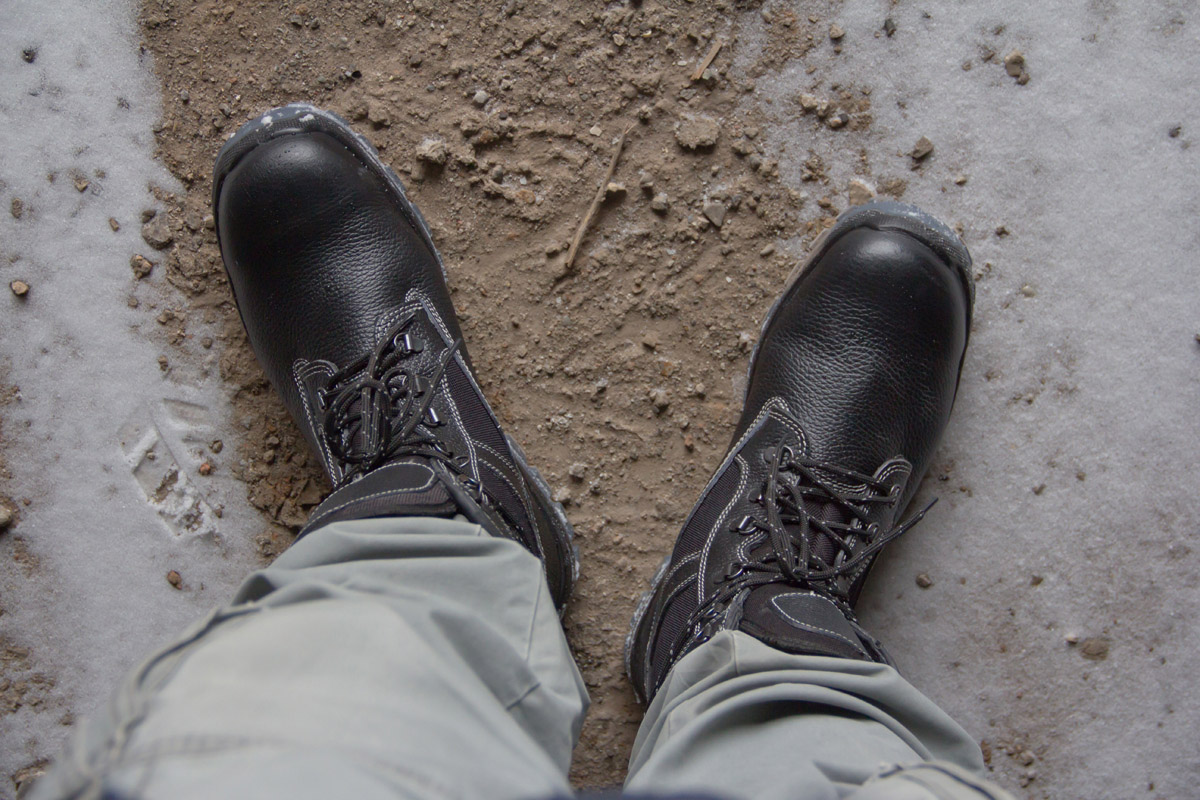

Protective Footwear Requirements
By Grainger Editorial Staff 1/31/19


Quick Tips #252
Hazards exist in every workplace, in many different forms. The best way to protect employees is to control these hazards at the source, using elimination, substitution, engineering and administrative control measures. When these controls do not provide enough protection, proper personal protective equipment (PPE) must be used.
What Is the OSHA Standard for Safety Shoes (Protective Footwear)?
Protective footwear (also known as safety shoes) falls under OSHA PPE requirements for general industry, which are given in 29 Code of Federal Regulations (CFR) 1910 Subpart I. General requirements for all PPE are spelled out in 1910.132, and specific foot protection requirements are in 1910.136.
According to 29 CFR 1910.132, PPE must be used whenever an employers‘ workplace hazard assessment shows that hazards that require PPE are present, or are likely to be present. Per 29 CFR 1910.136(a), “Each affected employee shall wear protective footwear when working in areas where there is a danger of foot injuries due to falling or rolling objects, or objects piercing the sole, and where such employee’s feet are exposed to electrical hazards.” Appendix B to Subpart I identifies the following occupations for which foot protection should be routinely considered: “shipping and receiving clerks, stock clerks, carpenters, electricians, machinists, mechanics and repairers, plumbers, assemblers, drywall installers and lathers, packers, wrappers, craters, punch and stamping press operators, sawyers, welders, laborers, freight handlers, gardeners and grounds keepers, timber cutting and logging workers, stock handlers and warehouse laborers.”
29 CFR 1910.136 incorporates by reference the ASTM F2412-05 Standard Test Methods for Foot Protection, F2413-05 Standard Specification for Performance Requirements for Protective Footwear and the American National Standards Institute (ANSI) American National Standard for Personal Protection — Protective Footwear (ANSI Z41-1999 and Z41-1991).
On March 1, 2005, the ANSI Z41 reference was withdrawn and replaced by the ASTM Standards. On September 9, 2009, OSHA revised the PPE sections of OSHA’s general industry, shipyard employment, longshoring and marine terminals standards regarding requirements for eye and face protective devices, and head and foot protection.
The revision updated the references in these regulations to recognize the three most recent editions of the applicable national consensus standards and allows employers to use PPE constructed in accordance with any of the three.
ASTM F2412-18a (Standard Test Methods for Foot Protection) and ASTM F 2413-18 (Standard Specification for Performance Requirements for Protective (Safety) Toe Cap Footwear) are the most current footwear consensus standards. This document provides an overview of ASTM F2413-18.
What Does ASTM F2413-18 Mean?
ASTM F2413-18 is a standard that covers footwear constructed and manufactured such that the protective toe cap is an integral and permanent part of the footwear. The standard contains requirements to evaluate the performance of footwear for:
- Impact resistance
- Compression resistance
- Metatarsal protection
- Conductive protection
- Electric hazard resistance
- Static dissipative properties
- Puncture resistance
Footwear certified as meeting ASTM F2413-18 must first meet the requirements of ASTM F2412-18a Section 5.2 for impact resistance and 5.3 for compression resistance. Then the requirements of additional sections such as metatarsal protection, conductive protection, electric hazard resistance, static dissipative properties and protection against punctures can be met.
The requirement for impact resistance (section 5.2) is that when subjected to a 75 pound force, the toe area must provide a minimum interior height clearance of 0.5 inches in men’s footwear and 0.468 inches in women’s footwear. The interior height clearances are the same for compression resistance (section 5.3), and the footwear is subjected to a 2,500 pound force.
All footwear manufactured to the ASTM specification must be marked with the specific portion of the standard with which it complies. One shoe of each pair must be clearly and legibly marked (stitched in, stamped on, pressure sensitive label, etc.) on either the surface of the tongue, gusset, shaft or quarter lining. The marking must be enclosed in a rectangular border, and a four-line format is suggested. Line four is used only when more than three sections of the standard applies to the footwear. Each protective toe cap must be marked with the manufacturer’s name, trademark or logo. The cap number or identification, toe cap size and R (right) or L (left) must be permanently stamped or marked in a conspicuous location. Each metatarsal and puncture-resistant device must be marked with the manufacturer’s name, trademark or logo and device number or identification in a conspicuous location.
The following is an example of an ASTM F2413-18 marking that may be found on protective footwear:
ASTM F2413-18
M/I/C
EH
Line #1: ASTM F2413-18
This line identifies the ASTM standard. It indicates that the protective footwear meets the performance requirements of ASTM F2413 issued in 2018.
Line #2: M/I/C
This line identifies the gender (M [Male] or F [Female]) for which the footwear is intended. It also identifies the existence of impact resistance (I) and compression resistance (C).
Lines 3 & 4: EH
Lines 3 and 4 are used to identify footwear made to offer protection from other specific types of hazards referenced in the standard. They are used to designate metatarsal protection (Mt), conductive (Cd) properties, electrical hazard resistance properties (EH), footwear designed to reduce the accumulation of excess static electricity (SD) and puncture resistance (PR).
Metatarsal (Mt) footwear reduces the chance of injury to the metatarsal bones on the top of the foot. The protection must be an integral and permanent part of the footwear and is measured after exposure to a 75 pound force. The required height clearance for men’s footwear is one inch and for women’s footwear it is 0.937 inches after exposure.
Conductive (Cd) footwear is intended to provide protection for the wearer against hazards that may result from static electricity buildup and to help reduce the possibility of ignition of explosives or volatile chemicals. The footwear must facilitate electrical conductivity and the transfer of static electricity buildup from the body to the ground. The electrical resistance must range between zero and 500,000 ohms.
Electrical hazard (EH) footwear is manufactured with non-conductive, electrical-shock-resistant soles and heels. The outsole is intended to provide a secondary source of electric-shock-resistance protection to the wearer against the hazards from an incidental contact with live electrical circuits or electrically energized conductors, parts or apparatus. It must be capable of withstanding the application of 18,000 volts at 60 hertz for one minute with no current flow or leakage current in excess of one milliampere under dry conditions.
Static dissipative (SD) footwear is designed to provide protection against hazards that may exist due to excessively low footwear resistance, as well as maintain a sufficiently high level of resistance to reduce the possibility of excess static electricity and electric shock. Three different levels of electrical resistance are designated: SD 100, SD 35, and SD 10, based upon the following parameters:
- SD 100 — a lower limit of electrical resistance of 106ohms (1 megohm) and an upper limit of electrical resistance of 108ohms (100 megohms).
- SD 35 — a lower limit of 106ohms and an upper limit of 3.5 x 107ohms (35 megohms).
- SD 10 — a lower limit of electrical resistance of 106ohms and an upper limit of 1.0 x 107ohms (10 megohms).
Puncture-resistant (PR) footwear is designed with a puncture-resistant plate is positioned between the insole and outsole. Puncture resistant components must reduce the possibility of injury caused by sharp objects that can penetrate the bottom of the footwear. The puncture resistant component must be an integral and permanent part of the footwear. A positive test result is achieved if the footwear’s bottom can be subjected to a 270 pound force without visual signs of penetration. The device must also show no sign of corrosion after being exposed to a five percent salt solution for 24 hours.
Any changes to the original components of safety toe footwear, such as replacing or adding aftermarket footbeds/inserts, could cause failure to any or all parts of the ASTM F2412-18a and F2413-18 standards, and the marking would be invalid. Any change in the insole material thickness greater than 25% requires the footwear to be retested.
With each new year date revision of ASTM F2413, footwear manufactures/providers are required to recertify existing styles within one year of the issuing date.
Add-On Devices
An important point to remember is that ASTM F2413-18 does not allow for the use of add-on type devices (strap-on foot, toe or metatarsal guards) as a substitute for protective footwear. According to both ASTM F2413-18 and ASTM F2412-18a, any protective toe cap or metatarsal guard must be designed, constructed and manufactured into the protective footwear during the manufacturing process and tested as an integral part of the footwear.
While ASTM excludes add-on devices, it doesn’t necessarily mean they’re not acceptable to OSHA. This paradox exists because OSHA states in 1910.136(b)(2): “Protective footwear that the employer demonstrates is at least as effective as protective footwear that is constructed in accordance with one of the above consensus standards will be deemed to be in compliance with the requirements of this section.” This means that if an employer can provide documentation, such as testing data proving their add-on devices provide protection equivalent to any of the incorporated by reference performance standards, then the add-on devices are acceptable to OSHA. Most manufacturers of add-on devices have submitted their products to independent laboratories for testing. This data and its results can usually be obtained upon request.
Commonly Asked Questions
Q: What is a composite safety toe shoe?
A: As the name suggests, instead of steel, composite toe shoes have a type of composite material in them. These materials are usually a combination of plastic, Kevlar® and carbon fibers. Steel and other alloy materials are stronger than the composite materials. Because the composite materials are not quite as strong as the steel and other alloys, the composite toes have to be thicker and more bulbous. This limits the styles that can effectively use composite toes.
Q: When is footwear with impact and compression protection suggested for use?
A: Per Appendix B to Subpart I, safety shoes or boots with impact protection are suggested for carrying or handling materials such as packages, objects, parts or heavy tools, which could be dropped, and for other activities where objects might fall onto the feet. Safety shoes or boots with compression protection are suggested for work activities involving skid trucks, around bulk rolls (such as paper rolls) and around heavy pipes, all of which could potentially roll over an employee’s feet.
Q: Does ASTM F2313-18 address the slip resistance of footwear?
A: No, this standard does not address slip resistance. There once was an ASTM Standard on slip resistant footwear, ASTM F1677, but that was withdrawn in 2006. There is an independent testing organization in Great Britain known as SATRA that tests footwear for a wide variety of performance criteria, with slip resistance being one. And while footwear isn’t part of its scope, there is an organization in the U.S., the National Floor Safety Institute, that has established testing criteria and has approved a variety of floor treatments based upon slip resistance.
The information contained in this article is intended for general information purposes only and is based on information available as of the initial date of publication. No representation is made that the information or references are complete or remain current. This article is not a substitute for review of current applicable government regulations, industry standards, or other standards specific to your business and/or activities and should not be construed as legal advice or opinion. Readers with specific questions should refer to the applicable standards or consult with an attorney.







